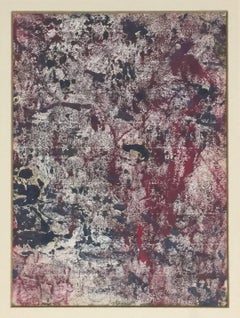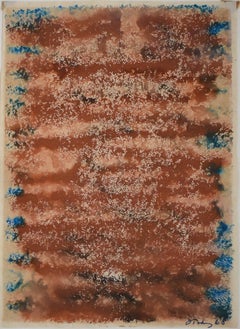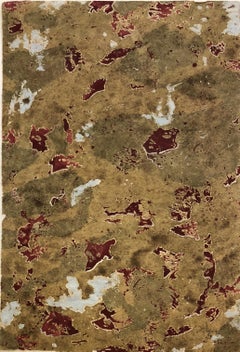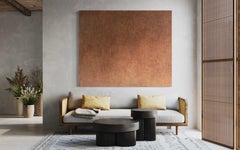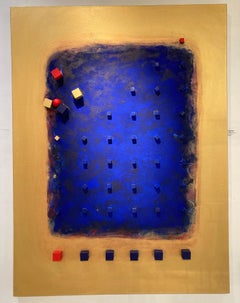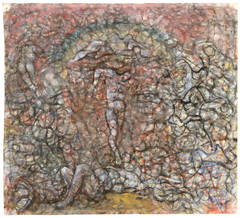Mark Tobey Abstract Paintings
American, 1890-1976
Mark George Tobey (December 11, 1890 – April 24, 1976) was an American painter. His densely structured compositions, inspired by Asian calligraphy, resemble Abstract expressionism, although the motives for his compositions differ philosophically from most Abstract Expressionist painters.to
3
Overall Width
to
Overall Height
to
3
3
2
3
3
3
2
1
46
664
620
458
342
3
Artist: Mark Tobey
Abstract Flock - Monotype, Oil and Tempera on Paper - 1965 ca.
By Mark Tobey
Located in Roma, IT
This original artwork by Mark Tobey is a Monotype with tempera, heightened with tempera on paper.
Signed Tobey lower right
Signed Mark Tobey with the remark GOOD! on the back.
Prove...
Category
1960s Abstract Mark Tobey Abstract Paintings
Materials
Mixed Media, Oil, Tempera
Composition - American painting, Post War Art
By Mark Tobey
Located in London, GB
MARK TOBEY 1890-1976
Centerville 1890 - 1976 Basel (American)
Title: Composition, 1968
Technique: Original Tempera Painting on Paper
Paper size: 15.5 x 11.5 cm. / 6.1 x 4.5 in.
...
Category
1960s Mark Tobey Abstract Paintings
Materials
Tempera
Untitled - Mixed Media by Mark Tobey - 1969
By Mark Tobey
Located in Roma, IT
Untitled is an artwork by Mark Tobey. Monotype with tempera, heightened with tempera on Japan paper.
Hand signed and dated lower right: Tobey 69.
Provenance: Henze Ketterer Gallery
B...
Category
1960s Abstract Mark Tobey Abstract Paintings
Materials
Mixed Media, Tempera
Related Items
Original Contemporary Minimalist Large scale Texture painting Burnt Orange Oil
By Svetlana Shalygina
Located in Maricopa, AZ
"The Sacred Color" is an original minimalist oversized painting by the late Svetlana Shalygina. It is a part of the limited series sought after by interior designers for its ability ...
Category
2010s Abstract Expressionist Mark Tobey Abstract Paintings
Materials
Mixed Media, Acrylic
$5,600 Sale Price
22% Off
H 59 in W 72 in D 2.5 in
'Surfacing II, ' by Dragana Milovic, Mixed Media Painting
Located in Oklahoma City, OK
This 48" x 34" mixed media painting, 'Surfacing II,' by Dragana Milovic features an abstracted geometric composition featuring 3d objects adhered to th...
Category
2010s Abstract Geometric Mark Tobey Abstract Paintings
Materials
Gold Leaf
$6,000 Sale Price
30% Off
H 48 in W 34 in D 3.25 in
Contemporary Minimalist Abstract Textured Large Scale Painting
By Svetlana Shalygina
Located in Maricopa, AZ
A rare opportunity to own a very unique and special painting by the late Svetlana Shalygina. This piece is titled "Straightforward" and it sure makes a statement from every angle. It...
Category
2010s Abstract Mark Tobey Abstract Paintings
Materials
Mixed Media, Acrylic
$6,560 Sale Price
20% Off
H 72 in W 48 in D 2.5 in
"Gypsy" Signed Mixed Media Abstract by Ellie Riley, 5-Foot Large-Scale Canvas
Located in Miami, FL
ELLIE RILEY – "GYPSY"
Mixed Media on Canvas ⚜ Hand Signed, Titled, and Dated on Verso ⚜ Frameless Display
VIBRANT ABSTRACT WITH ORGANIC SHAPES AND KINETIC ENERGY
A striking large-sc...
Category
Early 2000s Abstract Mark Tobey Abstract Paintings
Materials
Acrylic, Mixed Media, Canvas
$8,500
H 60 in W 60 in D 2 in
Mid Century Abstract Original Painting - Blue Calligraphy on Crimson Water
By Honora Berg
Located in Soquel, CA
Mid Century Abstract Original Painting - Blue Calligraphy on Crimson Water in Oil and Tempera on Paper
Wonderful Bay Area abstract composition by San Francisco's artist Honora Berg ...
Category
1940s Abstract Expressionist Mark Tobey Abstract Paintings
Materials
Paper, Oil, Tempera
$1,320 Sale Price
20% Off
H 22 in W 28 in D 0.1 in
Untitled Abstraction-008 casein tempera on board by Vaclav Vytlacil
By Vaclav Vytlacil
Located in Hudson, NY
Signed and dated "Vytlacil 38" lower left, and signed and dated verso.
Provenance: Estate of the artist #1602; Martin Diamond Fine Art
About this artist: Born in 1892 to Czechoslov...
Category
1930s Abstract Expressionist Mark Tobey Abstract Paintings
Materials
Tempera, Casein, Board
Le Printemps gris
Located in PARIS, FR
Jacqueline Pavlowsky was born in 1921 in Vincennes to Russian and Polish Jewish parents who had immigrated to France. After the war, she started her studies of chemistry, while at th...
Category
1970s Abstract Mark Tobey Abstract Paintings
Materials
Canvas, Tempera
Black
By Enrico Benetta
Located in Miami, FL
"Black" is a painting created by Enrico Benetta in 2012. The artwork is the first of a series of monochromatic square canvasses created each in one of the primary colors. The paintin...
Category
21st Century and Contemporary Abstract Mark Tobey Abstract Paintings
Materials
Gesso, Paper, Ink, Mixed Media, Acrylic
What You All Want ??? - Contemporary Figurative Painting, Polish Young Art
Located in Salzburg, AT
Kasia Mazur is a very young artist, she is still studying painting at the Academy of Fine Arts in Gdansk, where she also lives. She has already had exhibit...
Category
2010s Contemporary Mark Tobey Abstract Paintings
Materials
Cotton Canvas, Oil, Acrylic, Tempera
$920
H 39.38 in W 28.75 in D 0.79 in
Kibbutz Abstract Jerusalem Nightscape Israeli Tempera Collage Painting Judaica
Located in Surfside, FL
Abstract Expressionist cityscape of Old City of Jerusalem in moody blues and gold. Yitzhak Greenfield, painter, born 1932, Brooklyn, New York His focus is on the heavenly and the terrestrial Jerusalem; on the Hebrew alphabet; and on central themes in Jewish tradition and culture. He deals with the tension between figurative and abstract.
Education
1946 Educational Alliance Art School, New York City, with Abba Ostrowsky, Chaim Gross, and Louis Lozowick.
1948 Thomas Jefferson High School, Brooklyn, New York, Art
1953 Drawing and Drawing Wall Murals,Seminar at Givat Haviva with P. Pelzig, Yohanan Simon, and Naftali Bezem.
1960 Printmaking with the artist and printmaker Borin, Venice, Italy
1979-1981 Morris Blackburn Print Workshop, New York City, U.S.A.
Teaching
Art Kibbutz Gal-On and Gat
1961-1963 Arts, regional school at Mateh-Yehuda
Regional school, Mate-Yehuda
Anglican school, Jerusalem
1965–70 Bet Ha'am, Popular University Outreach Program, Jerusalem
Ruth Youth Wing, Israel Museum, Jerusalem
Shira Mushkin: Majestic scenes in blue, gold and indigo, radiating spheres and grand expanses hover above architectural forms and clusters of Hebrew letters, revealing dreamlike realities. These are the creations of the artist Yitzhak Greenfield who works in watercolor and acrylic paints layered with collages of painted papers, discarded book materials, and fragments of his own prints. Applying parts of broken furniture, clock springs, iron locks and keys, the artist forms assemblages that hint at familiar settings, resonating the past. For Brooklyn born, Israeli artist Yitzhak Greenfield, these visions are the essence of the Jerusalem landscape, inspired by the city’s ever-changing magical scenery.
For generations, Jerusalem has been a focal point for the Jewish people. It is the center of Jewish life, faith, hope, history, and consciousness. Jerusalem holds a particular significance for Greenfield, who moved to Ein Kerem, Jerusalem over fifty years ago, after living on a kibbutz. Greenfield is a Jerusalem artist, and he remarks: “Living and working in Jerusalem is a special journey for me. My works are visionary landscapes, which are reconstructions of Jerusalem, not always relating to specific sites.” The artist has always been intrigued by the historical and dynamic nature of the city, as he constantly explores his own connection to the traditional and spiritual forms of Judaism. Greenfield’s art is linked to Jewish and Israeli history and symbols, such as the Hebrew letters, Jewish amulets, and the Ten Sephirot (Kabbalah emanations), containing aesthetic qualities of the material and the spiritual.
Working in a distinctive modernist method, Greenfield’s artwork lends itself to rich possibilities of expression. The exhibition Yitzhak Greenfield: Exploring Jerusalem comprises three main series from the artist’s career, which span over the course of many years and continue to this day; Jerusalem Visions, Jerusalem Assemblages, and Landscape and Meditation on the Hebrew Letter. These artworks portray timeless dream-landscapes of Jerusalem. The hidden secrets of the city are locked away in assemblage constructions, and prints depicting Hebrew letters illuminate into mystical meanings. The spectator travels along with Greenfield through his creations, exploring Jerusalem and experiencing a spiritual and living Judaism, in which the artist constantly searches for the expression of his cultural and spiritual legacy as he reconstructs Jerusalem.
1966 General Exhibition - Jerusalem Artists' House
Artists: Hirszenberg, Samuel Boris Schatz, Lilien, Ephraim Moses, Joseph Budko, Leopold Krakauer, Meir Gur Arie, Jacob Eisenberg, Ben Zvi, Zeev Palombo...
Category
1960s Abstract Expressionist Mark Tobey Abstract Paintings
Materials
Mixed Media, Tempera
California Monoprint
By Kory Twaddle
Located in Kansas City, MO
Artist : Kory Twaddle
Title : California Monoprint
Materials : Tempera on paper
Date : 2008
Dimensions : 36 x 24 x .1 in.
Kory Twaddle is a Kansas City based artist and Research A...
Category
Early 2000s Abstract Mark Tobey Abstract Paintings
Materials
Paint, Paper, Conté, Charcoal, India Ink, Acrylic, Tempera, Watercolor, ...
Contemporary textured abstract original mixed media painting, minimalist
By Svetlana Shalygina
Located in Maricopa, AZ
A stunning original abstract by the late Svetlana Shalygina with heavy texture on top and subtle dark grey crackle on bottom with a white band in the middle. This contemporary mixed ...
Category
2010s Abstract Impressionist Mark Tobey Abstract Paintings
Materials
Mixed Media, Acrylic, Pen
$4,160 Sale Price
25% Off
H 48 in W 12 in
Previously Available Items
Untitled
By Mark Tobey
Located in Palm Desert, CA
Gouache on paper
Mark George Tobey (1890-1976) was an American painter. His densely structured compositions, inspired by Asian calligraphy, resemble Abstract expressionism, although the motives for his compositions differ philosophically from most Abstract Expressionist painters. His work was widely recognized throughout the United States and Europe. Along with Guy Anderson, Kenneth Callahan, Morris Graves, and William Cumming, Tobey was a founder of the Northwest School...
Category
1960s Contemporary Mark Tobey Abstract Paintings
Materials
Gouache
Mark Tobey abstract paintings for sale on 1stDibs.
Find a wide variety of authentic Mark Tobey abstract paintings available for sale on 1stDibs. You can also browse by medium to find art by Mark Tobey in paint, tempera, mixed media and more. Much of the original work by this artist or collective was created during the 1960s and is mostly associated with the abstract style. Not every interior allows for large Mark Tobey abstract paintings, so small editions measuring 5 inches across are available. Customers who are interested in this artist might also find the work of Johnny Taylor, Anne Harney, and Gregg Renfrow. Mark Tobey abstract paintings prices can differ depending upon medium, time period and other attributes. On 1stDibs, the price for these items starts at $4,500 and tops out at $12,477, while the average work can sell for $11,698.
